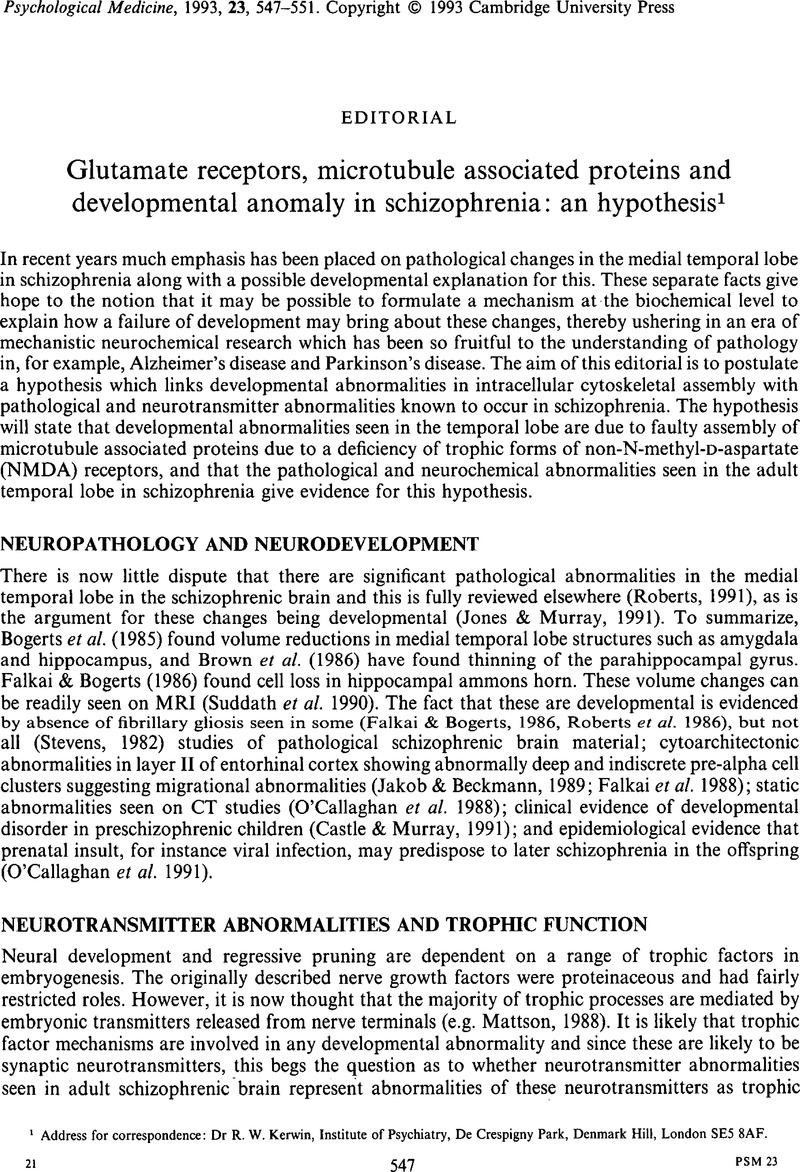Crossref Citations
This article has been cited by the following publications. This list is generated based on data provided by Crossref.
Eastwood, Sharon L.
McDonald, Brendan
Burnet, Philip W.J.
Beckwith, Jason P.
Kerwin, Robert W.
and
Harrison, Paul J.
1995.
Decreased expression of mRNAs encoding non-NMDA glutamate receptors GluRl and GluR2 in medial temporal lobe neurons in schizophrenia.
Molecular Brain Research,
Vol. 29,
Issue. 2,
p.
211.
1995.
Clinical Neuropsychology.
p.
381.
Glenthøj, Birte Y.
and
Hemmingsen, Ralf
1997.
Dopaminergic sensitization: Implications for the pathogenesis of schizophrenia.
Progress in Neuro-Psychopharmacology and Biological Psychiatry,
Vol. 21,
Issue. 1,
p.
23.
Goff, Donald C.
and
Wine, Lara
1997.
Glutamate in schizophrenia: clinical and research implications.
Schizophrenia Research,
Vol. 27,
Issue. 2-3,
p.
157.
Hameroff, Stuart R.
1997.
Matter Matters?.
p.
61.
Eastwood, Sharon L.
Kerwin, Robert W.
and
Harrison, Paul J.
1997.
Immunoautoradiographic evidence for a loss of α-amino-3-hydroxy-5-methyl-4-isoxazole propionate-preferring non-N-methyl-D-aspartate glutamate receptors within the medial temporal lobe in schizophrenia.
Biological Psychiatry,
Vol. 41,
Issue. 6,
p.
636.
Devon, Rebecca S.
Evans, Kathryn L.
Maule, John C.
Christie, Sheila
Anderson, Susan
Brown, John
Shibasaki, Yoshiro
Porteous, David J.
and
Brookes, Anthony J.
1997.
Novel transcribed sequences neighbouring a translocation breakpoint associated with schizophrenia.
American Journal of Medical Genetics,
Vol. 74,
Issue. 1,
p.
82.
Cotter, David
Kerwin, Robert
Doshi, Bala
Martin, Carlos Sanchez
and
Everall, Ian Paul
1997.
Alterations in hippocampal non-phosphorylated MAP2 protein expression in schizophrenia.
Brain Research,
Vol. 765,
Issue. 2,
p.
238.
Boulenguez, P.
Peters, S.L.
Mitchell, S.N.
Chauveau, J.
Gray, J.A.
and
Joseph, M.H.
1998.
Dopamine release in the nucleus accumbens and latent inhibition in the rat following microinjections of a 5 -HT1B agonist into the dorsal subiculum: implications for schizophrenia.
Journal of Psychopharmacology,
Vol. 12,
Issue. 3,
p.
258.
Bullmore, Edward T.
Woodruff, Peter W.R.
Wright, Ian C.
Rabe-Hesketh, Sophia
Howard, Robert J.
Shuriquie, Nasser
and
Murray, Robin M.
1998.
Does dysplasia cause anatomical dysconnectivity in schizophrenia?.
Schizophrenia Research,
Vol. 30,
Issue. 2,
p.
127.
Chih-Hui Chen, Andrew
McDonald, Bernard
Moss, Stephen J
and
Gurling, Hugh M.D
1998.
Gene expression studies of mRNAs encoding the NMDA receptor subunits NMDAR1, NMDAR2A, NMDAR2B, NMDAR2C, and NMDAR2D following long-term treatment with cis- and trans-flupenthixol as a model for understanding the mode of action of schizophrenia drug treatment.
Molecular Brain Research,
Vol. 54,
Issue. 1,
p.
92.
Chen, Andrew Chih-Hui
and
Gurling, Hugh M.D
1999.
D2 dopamine receptor but not AMPA and kainate glutamate receptor genes show altered expression in response to long term treatment with trans- and cis-flupenthixol in the rat brain.
Molecular Brain Research,
Vol. 68,
Issue. 1-2,
p.
14.
Kyosseva, Svetlana V
Elbein, Alan D
Griffin, W.Sue T
Mrak, Robert E
Lyon, Melvin
and
Karson, Craig N
1999.
Mitogen-activated protein kinases in schizophrenia.
Biological Psychiatry,
Vol. 46,
Issue. 5,
p.
689.
Goff, Donald
2000.
Neurotransmitter Receptors in Actions of Antipsychotic Medications.
Vol. 20000744,
Issue. ,
p.
121.
Cotter, David
Wilson, Simon
Roberts, Eleanor
Kerwin, Robert
and
Everall, Ian Paul
2000.
Increased dendritic MAP2 expression in the hippocampus in schizophrenia.
Schizophrenia Research,
Vol. 41,
Issue. 2,
p.
313.
Goff, Donald C.
and
Coyle, Joseph T.
2001.
The Emerging Role of Glutamate in the Pathophysiology and Treatment of Schizophrenia.
American Journal of Psychiatry,
Vol. 158,
Issue. 9,
p.
1367.
Futamura, T
Toyooka, K
Iritani, S
Niizato, K
Nakamura, R
Tsuchiya, K
Someya, T
Kakita, A
Takahashi, H
and
Nawa, H
2002.
Abnormal expression of epidermal growth factor and its receptor in the forebrain and serum of schizophrenic patients.
Molecular Psychiatry,
Vol. 7,
Issue. 7,
p.
673.
Heresco-Levy, Uriel
2003.
Glutamatergic neurotransmission modulation and the mechanisms of antipsychotic atypicality.
Progress in Neuro-Psychopharmacology and Biological Psychiatry,
Vol. 27,
Issue. 7,
p.
1113.
van Beveren, Nico J.M.
van der Spelt, Job-Jeroen
de Haan, Lieuwe
and
Fekkes, Durk
2006.
Schizophrenia-associated neural growth factors in peripheral blood. A review.
European Neuropsychopharmacology,
Vol. 16,
Issue. 7,
p.
469.
Eastwood, Sharon L.
Lyon, Louisa
George, Lydia
Andrieux, Annie
Job, Didier
and
Harrison, Paul J.
2007.
Altered expression of synaptic protein mRNAs in STOP (MAP6) mutant mice.
Journal of Psychopharmacology,
Vol. 21,
Issue. 6,
p.
635.



